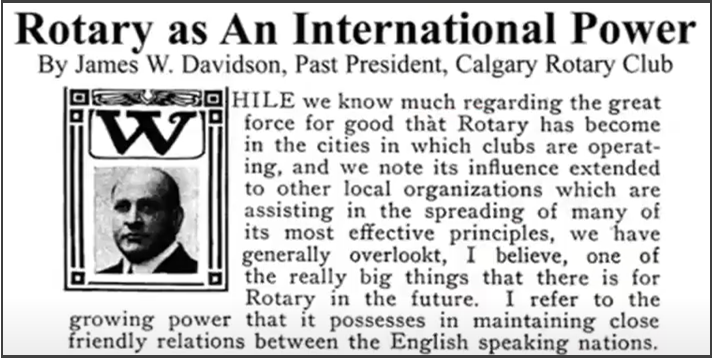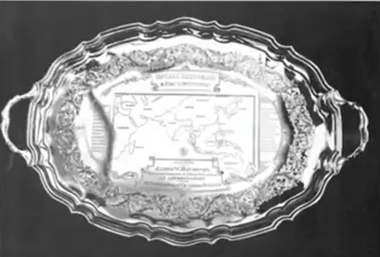 Program - Robert Lampard - James Wheeler Davidson Program - Robert Lampard - James Wheeler Davidson Dave Brauchler introduced the speaker. Dave said the bio was written by a close friend of speaker who describes him as one of the most remarkable and inspiring people he has ever met inside or outside of Rotary. He puts his whole heart into everything he does. One of the projects Dr. Lampard worked on was having a peak in Canada names after an esteemed Rotarian. Dave said that is likely one of the things Rotarians and guests will learn about during the presentation. Dr. Lampard began by saying it is always a pleasure to visit another Rotary Club - especially one that is as happy as Mesa West seems to be. He knows he is happy to be in Mesa. Where he lives, in Red Deer Alberta Canada, temperatures are much cooler. He was going to tell the story of a very remarkable person in Rotary history, a person about whom too little was known for about seventy years. He was truly a man of peace. In today's world - looking at the Ukraine invasion - the world could use a lot more men like James Wheeler Davidson. Bob has studied him over the last two decades. Davidson represents the finest example he was able to find of a man who builds good will and made better friendships. In his time, it was desired for Rotary to become world wide. Rotary is the only service organization that is truly world wide. Rotary started in 1905. By 1906 it had spread to San Francisco. It became international when it spread to Winnipeg in 1910 and to the UK in 1911. The first non-English speaking club was formed in Havana in 1916 during the war. District Governors during those years were encouraged to start new clubs in countries contiguous with theirs. They started paying commissioners to start new clubs to ensure the standards that they wanted were upheld. During World War I, Rotary International (called International Association of Rotary Clubs "IARC" at the time) did not permit the British Rotarians to participate in the war effort. The Brits weren't happy about that and they formed their own society within Rotary which still exists to this day. It is called RIBI. Who was he? Davidson was famous before he joined Rotary. Born in 1872 in Austin, Minnesota, by age 19, he was touring international celebrities like Sir Henry Stanley and Lt. Perry on speaking tours around the United States. Because of his contacts, he was able to join an expedition to the North Pole in 1923. It nearly cost him his life. His dogs ripped open his tent during a storm. His leg was frozen turning nearly hard as marble forcing a three-day evacuation. He was very fortunate to survive. The misadventure did not stifle his adventurous nature.  He went on to Formosa as the only journalist with syndicated papers in the United States agreeing to publish his articles. Formosa was in the hands of rioters. The Japanese arrived to take over Formosa while he was there. The Emperor of Japan was so impressed with Davidson he awarded him the Order of the Rising Sun saying he brought Japanese aid and saved the foreign resident's lives and property. The locals living in the mountains were head-hunters. Fortunately, Davidson didn't lose his head, but he did end up with a tattoo on the back of his hand which he wore for the rest of his life. When he finished, the US Consular service asked him to join them. He ended up at age 32 as acting chief consul at Shanghai, which was the largest Embassy the US had outside the US. He wrote a book titled "The Island of Formosa Past and Present" which is still in print today. Davidson left the consulate because "he wasn't being paid enough." He had developed some interesting and expensive hobbies by then. He also developed Typhoid Fever. He returned to the states on a stretcher. On his way home, he met a woman named Lillian and married her. He took her to Winnipeg where it was very cold and she gave him an ultimatum - "It's Winnipeg or me," so he took her to Calgary in 1907. He and his brother bought and sold 3/4 of a million acres of land very close to Calgary. They started a lumber company which still exists. He was never idle. He helped get the Calvary started. He was instrumental in getting the Calvary symphony started. He loved highways and strongly promoted them. He started a group called The Sunshine Trail Association to build a road from Calgary to Yellowstone and Salt Lake City with a side road to Glacier Park. That interchange became the foundation for the Glacier International Peace Park.  Davidson's life changed when he joined Rotary in 1914. He was Club President in 1919 and became District Governor in 1923. Before becoming District Governor, he had an article published in the Rotarian Magazine about the potential for promoting peace through Rotary. He set a record during his DG year of starting five new clubs. 1920 was a very significant year. International President Pete Snedecor. Four months after the American Congress voted not to enter the League of Nations, Davidson wrote an article that appeared in the Rotarian Magazine. Davidson believed that peace in the world could be achieved through Rotary. Incoming RI President. Pete Snedecor wanted to expand Rotary to Australia and New Zealand. He traveled to Calgary to meet with Davidson. He found the Calgary club one of the finest clubs he had ever visited and after spending time with Davidson, with their visions aligned, Davidson, who was a natural salesman, was ready to sell Rotary. Davidson headed for Australia to convert Australians to Rotary. He said he had a "spasm of joy" when the Rotary Club of Melbourn was chartered. The stories ranged from Rotary being a drinking club to being a secret agency for the prohibition party. Over 150 Australians and New Zealanders joined the four new Rotary Clubs that were formed. Davidson's many talents were recognized and he was recognized by Rotary as the 3rd Vice President in 1926-27. Paul Harris suggested Davidson take on the task of taking Rotary around the globe. After selling his company to his employees, he and he family began their charterint trip in Istanbul in 1928. It was intended to be an 8-month adventure which ended up lasting 30 months. Turkey was a low point. Their new president wouldn't give approval to a club being started there. Greece was a high point. He went on to Bombay where he wanted a "high class club" and he convinced four influential individuals who had been knighted to become charter members. He went on to Singapore. It was tough. They didn't want an American business club coming into a British territory. When they finally got a club chartered, a year later it had 128 members. Davidson participated in over 2,000 interviews. It was an interesting challenge adapting Rotary rules to Asian cultures. The clubs that were chartered during his expedition will be having their centennial anniversaries over the coming decade. When the Davidsons finally returned to North America, Rotary virtually shut down so the executives could travel by train to VanCouver to meet them. The Calgary club presented him with a beautiful silver tray showing the clubs that were chartered during the expedition.  The Davidsons spent $250,000 of their own money, experienced serious illnesses and survived and automobile accident in Malaya where their car car rolled over, fortunately the car landed over a ditch allowing them to escape. He missed the Seattle convention in 1932. Lillian, his wife, gave a speech in his stead. Sadly, Davidson died in 1933 of congestive heart failure. After Lampard learned that a mountain had been named after Davidson, he started looking into it, and couldn't find it anywhere on the map. After some diligent effort, he found it was true, but was determined that it was a fact that would never be known unless someone persevered to make official maps show the location of the mountain. His efforts paid off. After they were finally successful On August 2, 2003, Lampard's Rotary Club of Red Deer held a Rotary Meeting on top of Mount Davidson. In February, 2005, the building where the Calgary Club meets, allowed a Rotary Centennial painting honoring Davidson to reside in their lobby. A photo of the painting is on the front of Lampard's book about Davidson's life.
|